Playing with urethane bowling balls gives you a certain connective joy with the lane. You’ve got good control over your earlier hook and your symmetry, and it can be easier—provided you’re playing on a reasonably dry lane—to build that muscle memory connection between address, release, breakpoint and that satisfying smash that you hear from the pin deck.
It seems strange to call urethane balls ‘old school’ just 40 years or so after their appearance, but the science of combining and recombining different qualities of the core, filler and cover stock has seen a rush of new entries to the bowling ball market over the past couple of decades.
Reactive solid resins, reactive pearl and hybrid cover stocks all have their respective advantages in different playing conditions.
But sometimes you just want to apply yourself fully to mastering a ball with no strategic capacity for handling different oil patterns.
Sometimes you just want to get back to basics to relearn how to optimize the rev power latent in your own throwing arm, and to reschool yourself on the challenges of medium-traction geometry.
The Storm Pitch Black is still an incredibly popular ball, albeit succeeded by the Storm Pitch Blue, and by several enhanced urethane models since.
We’ll open with the ball’s specifications, and then talk about what the respective features add to the play experience before covering some of the ball’s latent limitations.
BALL REVIEW
The Specs
- Cover stock: Controll Solid Urethane—1000 grit sanded
- Core: Symmetrical Capacitator
- Delivered Undrilled
- Radius of Gyration: 2.57 (moderate)
- Differential: 0.022 (low, and low flare potential)
- Aesthetics: Matte Black with lime branding
The Headlines
The Storm Pitch Black is a good-looking, grippy and vintage-feel urethane ball which operates best in light oil or short pattern conditions.
The internal weight balance and 1000-grit surface will help the ball to hook early and handle high-rev releases. The Pitch Black is nice to control in the mid-lane and predictable in its motion from break point to pocket.
The Construction
Let’s look at the weight block first. The Capacitor Core, as Storm calls it, looks a little like a lightbulb that enjoyed a few pizzas over the Labor Day weekend. It’s tall within the body of the Pitch Black, but also gently squat in shape.
The RG on the 15lb ball (taking this as our average) is 2.57”, and the differential skimming the ‘low’ category at 0.022. If you take one of the lower weight balls, it’s good to be aware that the proportionate radial gyration measurement goes up to 2.63 on the 12lb balls.
The centralized, symmetrical balance afforded by the weight block’s positioning and shape makes the Storm Pitch Black (SPM) a nicely stable ball with a low (suppressed, even?) flare potential and very little migration between from the axis of release from your hand and the axis of impact into the pocket. In short, you can bowl straighter with the SPM and enjoy a much greater degree of control.
This ball is a polished diamond of a urethane classic and not a urethane ball tampered with to make it act like a reactive resin competitor.
This is just one reason that the urethane lovers of Reddit keep recommending it as the ball to add to your arsenal for the games taking place on rougher pattern conditions.
Like the weight block, the cover stock (Controll) surface coating is of Storm’s own devising. It’s porous, it’s highly durable, and the 1000 grit abalone surface does allow the ball to achieve its own traction, hook early, and follow a predictable path to the pin deck.
The SPB is a good option for those who opt to play at lower speeds but who manage to get a good number of revolutions into their spin.
The High Praise
As we’ve indicated, the SPB is one of the best bowling balls in its category for control, and is favorably compared to both the Natural and Supernatural as a ball which has good backend control, even if it doesn’t have a huge amount of power once it’s come out of the hook.
Even with a slight depletion of momentum, it still had a heavier arrival and better pin carry across several games than its successors.
It’s often commented that oil is the enemy of the Pitch Black, which may be something of an overstatement. It can perform well on Cheetah patterns (31 feet with an immediate foreground concentration of oil, tapering off towards the pin deck) and on the longer but similarly layered Wayne Webb 38’.
With urethane balls in general, it can definitely be difficult to keep traction and pace following the hook where balls which are not revolving quite fast enough become susceptible to skidding or vulnerable to premature roll-off. It does help that SPB has a little more torque and natural traction than most balls of its kind.
“Still hits like a truck” is a description which has come up quite a few times on the bowling forums, even among those who have had generally less positive experiences with skid-snappy urethanes wrecking their corner pin leave percentages and creating exasperating spare configurations.
It’s also pretty friendly on the budget as vintage-style must-haves go. There are more sophisticated balls out there which retail for less, but the Storm Pitch Black gives you many years’ worth of bowling for your money with a low maintenance refurbishment routine.
The limitations
Though it’s a supremely popular ball for its optimal use (drier conditions and shorter patterns), the SPB still has its detractors. Not many, admittedly, and most of the criticism isn’t personal, which is great for Storm.
The majority of the criticisms are aimed at the limited conditions in which balls like the SPB can work to best effect.
Okay, so we’ve mentioned the potential success of using the SPB on short patterns or drier areas. There is enough traction with that early hook for the SPB to scream towards the right-hand gutter, hug the edge, and then curve in for the pocket.
However, what the ball lacks (comparatively) in momentum as it approaches the pin deck, it can gain in overreaction as it completes the arc that the hook commits it to.
You can achieve a steep hook on a short-pattern lane and earn scores upward of 210 per game, but it struggles a little more on medium pattern set-ups. It’s said to be possible to achieve a solid pin contact into the pocket on a medium pattern at slow speed with lots of spin to avoid skid (and delay the roll-off effect), but those who struggle to release their ball with a sufficient flick for those high revs may find the SPB very frustrating.
In fairness, the SPB isn’t the best design for those who find it difficult to ramp up the revs. Getting that whiplash release at the right speed is something of an art form requiring a significant amount of patience.
Those of us who struggle with the revs often get along better with the balls which feature asymmetrical cores, where the significantly greater distribution of weight in focal spots helps the ball to keep momentum. The Storm Pitch Black’s interior is not set up that way.
At the very least, we can agree that the Storm Pitch Black gives the impression of bending sedately into the pin deck, having expelled nearly all its energy. We emphasized ‘impression’ because it is very difficult to gauge from watching video footage (thanks to the ball’s matte texture) the force with which the ball travels out of the hook before heading for the pocket.
Momentum is way easier to gauge with a ball featuring a brightly marbled cover stock, like the storm Parallax.
In any case, after many hours of reaction comparisons between the SPB and other urethane models in the same and competing lines, we must give critics their due on one point.
Although the ball’s mid-lane control is exemplary, and the traction exceptionally advanced for a non reactive-resin cover stock, the Storm Pitch Black might not have a sufficiently aggressive finish for a consistently strong performance over the upper medium to long patterns.
A Balancing Act
There is quite a bit of debate among the bowling vloggers as to whether urethane balls are truly for ‘dry lanes only’.
While this continues to be the dominant view, there is a good counter argument to suggest that any urethane ball played right out of the box is going to over-react and follow a wild arc after it’s come out of the hook.
This doesn’t necessarily mean that it’s rocketing helplessly through the carry-back layer which renders the lane ahead of the pit deck so unevenly slick. Nor does it mean that there is nominal control as your Storm Pitch Black comes out of that hook.
It just needs seasoning to wake up that porous cover stock and to tame the over-reaction. This can involve bowling your Storm Pitch Black perhaps up to fifteen times until you’ve adjusted for the best angle of play, speed, revolutions, and the ball’s performance becomes consistent.
In short, give it time to warm up and react like the top-notch urethane ball that it is, giving the Pitch Black its debut in its optimal performance environment.




Leave a Reply